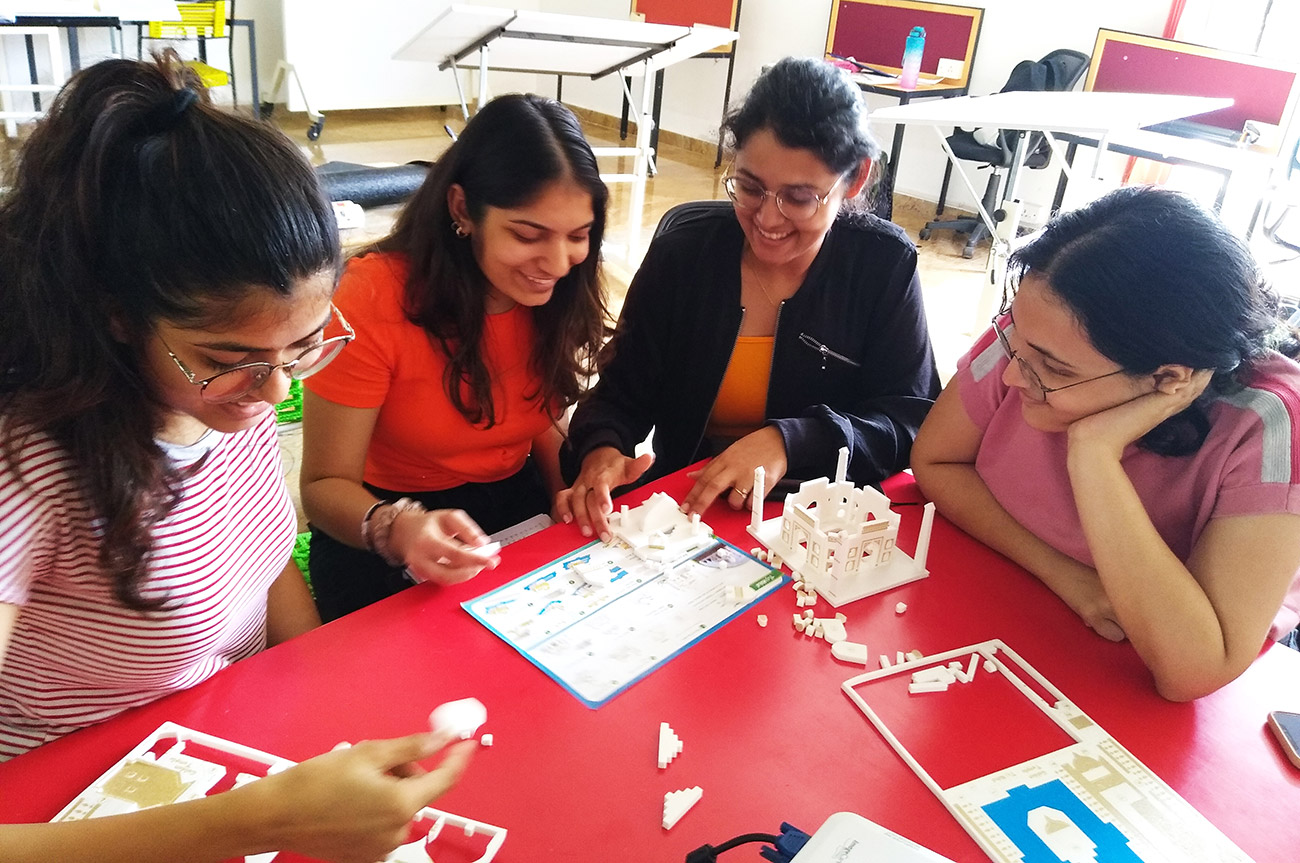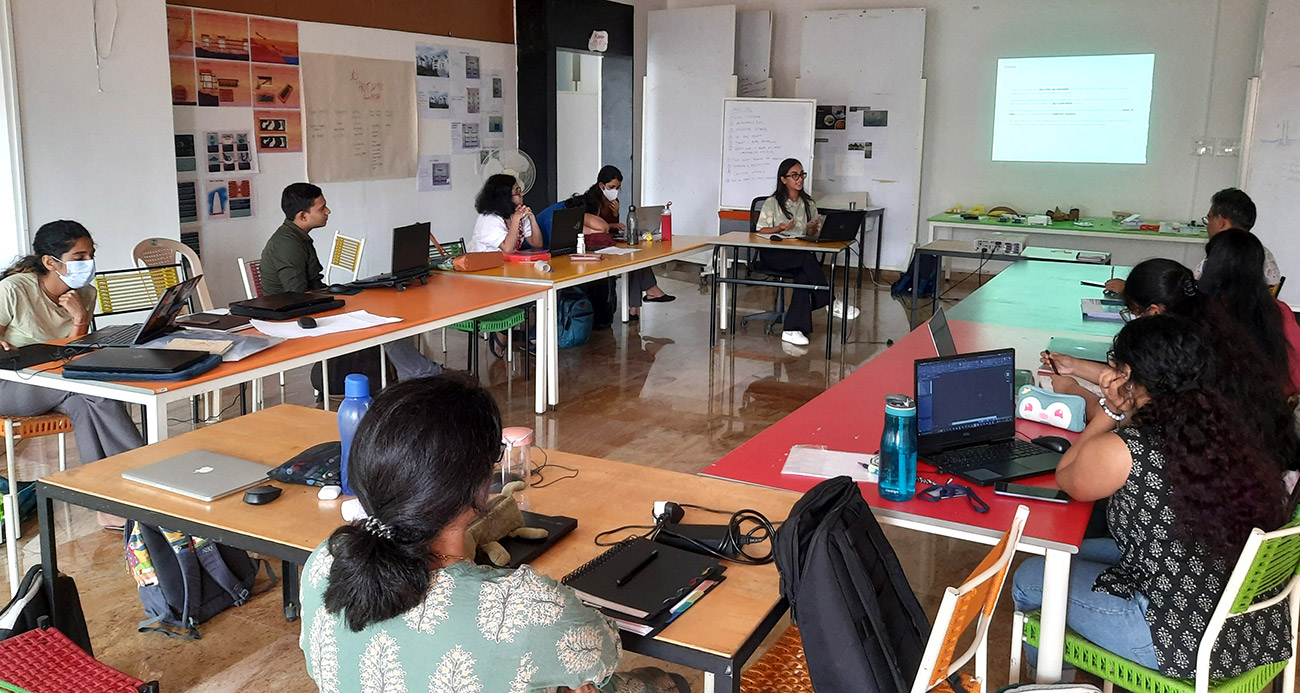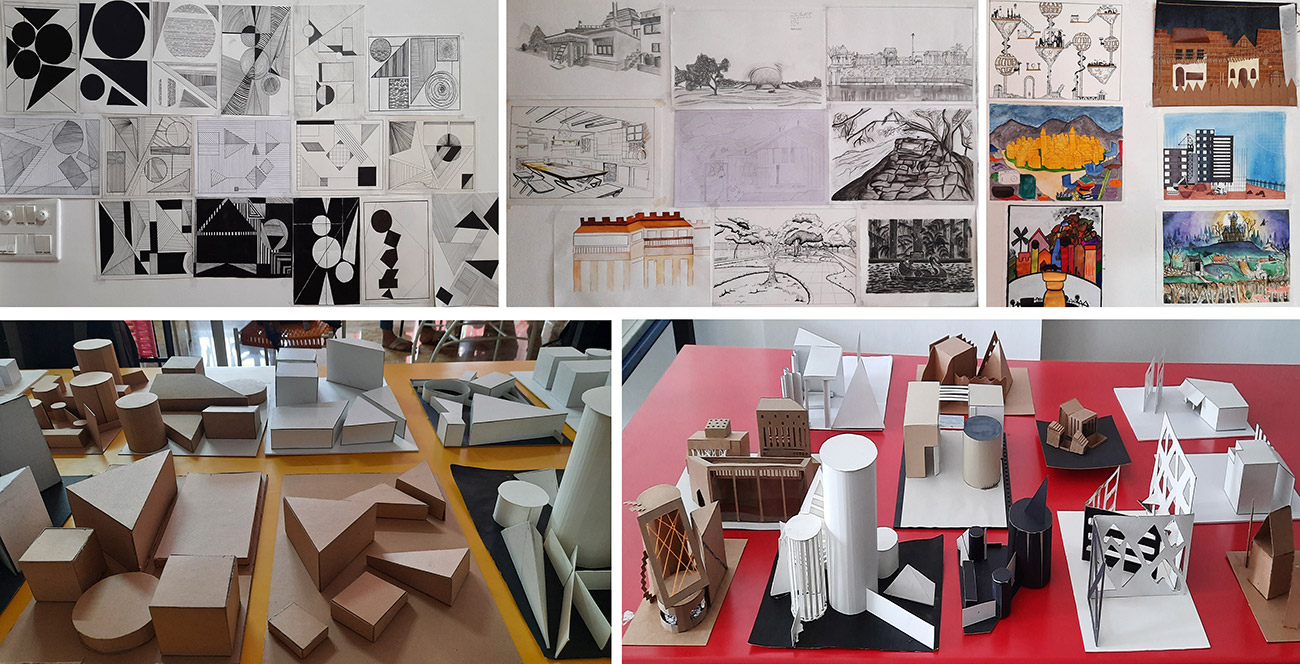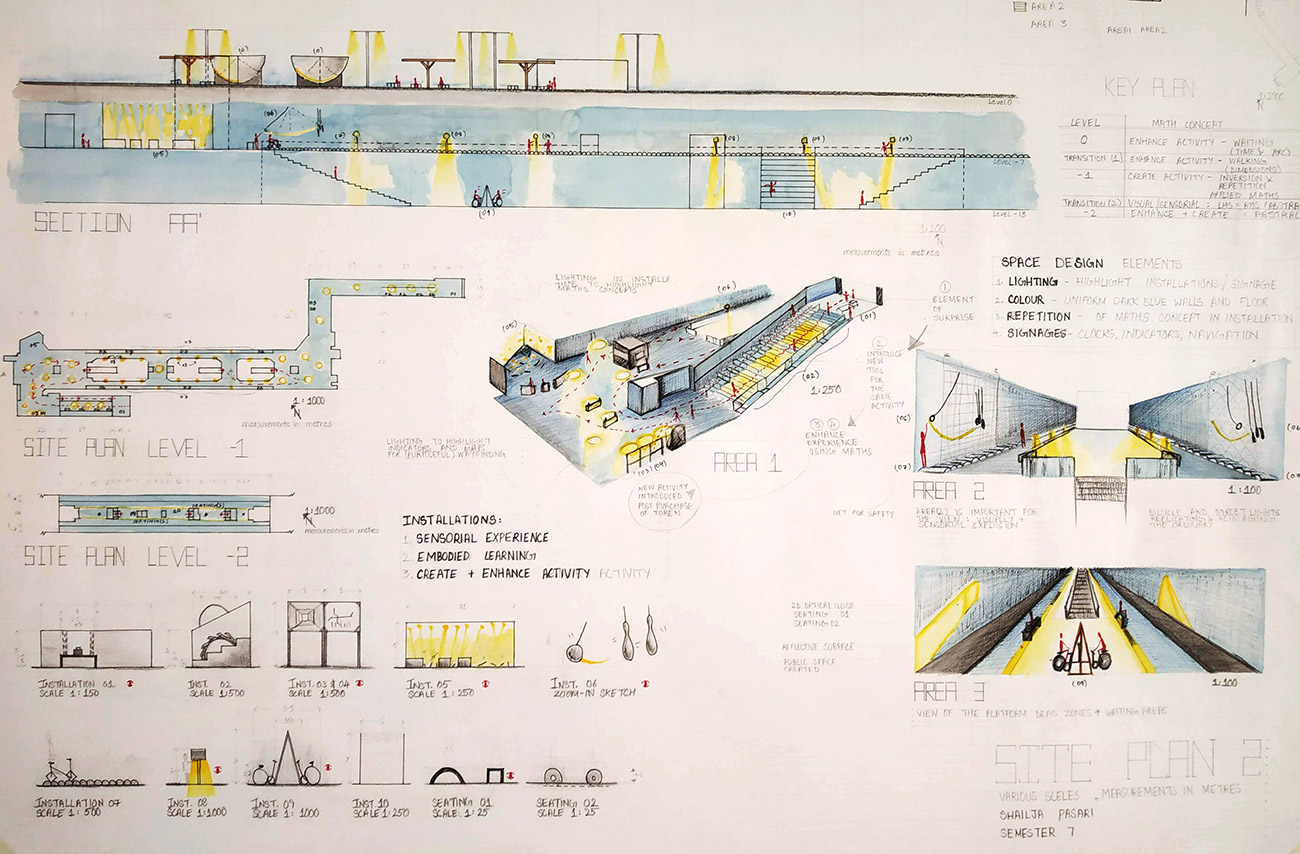Cultures and climate differ all over the world, but people are the same. They’ll gather in public, if you give them a good place to have it. - Jan Gehl

Second year Public Space Design students engaging with physical model-making as method to understand spaces through making.
Vision
Public spaces, whether interior or exterior, are places of collective experiences that in theory, are open and accessible to all members of a community - regardless of gender, race, ethnicity, age, or socio-economic backgrounds. Great spatial design opportunities exist in planned, unplanned, temporary and permanent spaces across diverse scales ranging from chai points to cafes, neighbourhood shops to retail hubs, from everyday meeting spaces to community centers, bus stops to places of mass transit, reading rooms to public libraries, from healthcare spaces to hospitality spaces, creative set designs to exhibition spaces to mention a few.
At a global scale, in the recent past, there has been a marked shift in spatial design practice and pedagogy towards interdisciplinary and trans-disciplinary design approaches and attitudes. The Public Space Design program at Srishti Manipal actively aligns with this ethos and cultivates a capacity to draw from diverse fields of knowledge, contextualize and develop creative visions for inclusive and sensitive spatial responses.
Since inclusivity and interdisciplinary learning are core ideologies of Public Space Design program, it does not insist on having any subject specific pre-requisites and welcomes applications from students who have pursued diverse subjects and streams.
The vision of the B. Des in Public Space Design aligns its graduates with diverse professional opportunities in the fields of architecture and interior design, product design, governmental and government-allied consultancy, community consultation & place-making practices, and many more. B. Des in Public Space Design program equips the aspiring spatial design practitioners to facilitate dialogues between stake holders in developmental projects, address challenges of global relevance such as climate change, sustainable development, urban inequality, and many others.
Core Values
The following are the core values that the program aims to instill in its aspiring practitioners:
- Empathy and passion for social inclusion and equity
- Contextual awareness and sensitivity towards community and culture
- Ecological consciousness and responsibility towards the environment
Course Structure
The curriculum comprises of different ways of learning as follows:
- Foundation introduces students to basic principles and tools of Art, Design and Technology as methods, tools and processes. Read more >>
- Disciplinary Studios are learning spaces where students develop core disciplinary capabilities, while navigating a trans-disciplinary environment
- General Studies is a common and compulsory programme of study that integrates Humanities, Sciences, Maths, business and finance. Development and Policy Studies and also offers Languages (Spanish, French and German) Read more >>
- Interim is an immersive introduction to practice in new and emerging areas of art and design and environmental exposure
- Electives are of three kinds - this program allows students to expand their skills, develop the interests as well as provide opportunities for travel exchange
- Internship/Apprenticeship is compulsory work experience done over the summer-break between the 6th and 7th semester
- Project based learning involves the application and synthesis of capabilities acquired. Two projects, pre-thesis and thesis, is culmination of the 4-year undergraduate program, which allows for demonstration of an integration of values, positions, capabilities and practice. Read more >>
Learning Approach
Learning at the undergraduate level in Public Space Design is driven by experience, experimentation and reflection
Learning happens through diverse modes of engagements:
- Skill-based-learning such as digital making, physical modelling in workshop spaces.
- Hands-on design-and-build interventions, in public spaces that may include art, furniture, or interactive installations.
- Studio-based learning that integrates theoretical understanding and practical application of concepts such as anthropometrics, universal design, sustainability, systems, and services and so on.
- Collaboration & co-design through participatory methodologies amongst peers, practitioners and the community under discussion.

Peer-learning through design presentation and feedback in the studio space is integral to every studio.
Capability Sets
Upon successful completion of this course graduates will have developed the following capabilities:
- To empathize, interact, collaborate & co-design with communities to understand and design for their needs and well-being.
- To effectively visualize, communicate and represent spatial design concepts and ideas to a larger audience.
- To give shape and form to ideas and concepts, make, prototype, and intervene.
- To work in professional environments with integrity and competence.
- To understand, explore and creatively work with materials, services, and systems.
- To understand complexities of multifaceted contexts and develop an integrated and comprehensive approach to design.
- To be able to think critically through reflection and identify patterns to independently develop one’s practice
Opportunities
Professional Practice:
With Public Space Design as major and allied minor & electives, Srishti Manipal equips and prepares the graduates to be contemporary design practitioners, entrepreneurs, design consultants for a wide range of career opportunities:
- Spatial design fields such as architecture & interior design,
- Urban design
- Heritage conservation & management
- Landscape design
- Place-making Initiatives
- Public policy making
- Development sector opportunities with government and government-allied agencies, consultancy and advocacy firms working in the urban or rural sector such as street (re)design, public space (re)design, design of public and public transit facilities etc.
- Set designs
- Exhibition Curation & Museum designs (Scenography)
- Furniture design
- Community consultation, user experience & design research
- Art activism & public art
- Spatial illustration & documentation
- Spatial & architectural journalism
Academic & Research Practice:
Public space design graduates from Srishti Manipal can peruse research opportunities as research assistants or independent researchers in leading research organizations working in diverse domains suggested above. Graduates interested in inquiry-based design research also have great opportunities to get involved with multiple centers and labs that are housed within Srishti Manipal. Additionally, graduates also develop expertise and eligibilities for perusing master's opportunities offered at Srishti Manipal as well as at other national & international universities of repute.
People
Enquiries

Disciplinary Intersections
The program is informed by the following learning disciplines:
Research and Collaboration
Srishti Labs (S.Labs)
LeNS Lab
DEL Lab
Centre for Experimental Media Arts (CEMA)
Impact Edge
Center for Education, Research, Training, and Development (CERTAD)

Work of second year Public Space Design students during the module titled ‘Communicating Spaces’ expresses the spatial analysis and design ideas through diverse mediums of communication & representation.

Pre-thesis project of fourth year Public Space Design student presents the spatial ideas for easy communication of math concepts in fun manner in transit spaces.
FAQs
Public Space Design is the discipline that focuses on the design of spaces that are 'public’ in nature and used by different living beings. Public spaces come in many forms- owned publicly or privately, such as but not limited to-
Spaces for recreation- parks, hospitality spaces, tea points, cafes, restaurants, community centers and so on.
Spaces for knowledge- anganwadis, schools, libraries, museums, and so on.
Spaces for care- health centers, clinics, daycares, and so on.
Spaces for commerce- neighbourhood stores, retail, bazaars, offices, and so on.
Temporal & Pop-up spaces that appear and disappear like flea markets, fairs, exhibitions, pavilions, and so on.
Public Infrastructure & Amenities- streets, sidewalks, bus stops and other transit facilities, public washrooms, and post offices.
The discipline synthesizes spatial design practices with natural, cultural, political, socio economic and historical contexts to arrive at a design response that is equitable, inclusive, just and resilient. Public Space Design draws from different spatial design disciplines, and brings together public art, digital storytelling, policy and planning.
The shared spaces that are 'public’ in nature often deal with pressures of urbanization and environmental challenges due to growth, climate change and spatial contestations. Now, more than ever is there a need for effective engagement with public spaces to allow for meaningful dialogue between the built and the open. It is in this domain that the quality of life is best expressed and experienced.
As such, anyone with an aptitude for collaboration, critical and analytical thinking and an all-encompassing approach to problem solving can participate in the process of public space design. This program is open to students from all academic backgrounds with interest in the community & cultures, spaces & places, living systems & sustainable Placemaking, to name a few. The program welcomes applications from students who have pursued diverse subjects and streams.
Students will develop an ability to observe, appreciate, understand, and analyze diverse scales of spaces that are essentially 'public’ in nature. It also enables students to develop spatial thinking abilities and responses that are context-sensitive with the needs of the 'other' in mind. Through project-based learning, be exposed to a wide range of perspectives and design criteria that aid and allow the process of conceptualizing spaces or places. Practical tools for designing spaces, skills for design communication, along with participatory tools, ethnography and other research methods will be key learning outcomes of this course.
Designers that engage with the public domain need to develop an understanding of cross disciplinary factors that influence the quality of public spaces. A clear understanding of planning, policy, community perspectives, participatory & co-design methods, and critical thinking, are key to enabling effective placemaking strategies. Practitioners get a chance to work with a diverse range of projects, contexts & clients, which could include spatial design & placemaking, advocacy for communities, and the development of policies and guidelines.
The Public Space Design program prepares the graduates to be contemporary design practitioners, entrepreneurs, and design consultants for a wide range of career opportunities in the fields of spatial design, architecture, interior design, development sector opportunities with government agencies, advocacy firms, NGOs & social enterprises working in the urban or rural sector & many creative & artistic practices that use ‘space’ as their medium/ platform for expression and narration.
The course also provides a foundation for students aspiring to undertake research positions or pursue further studies.
All admission and fee related information could be viewed on our admissions page.




